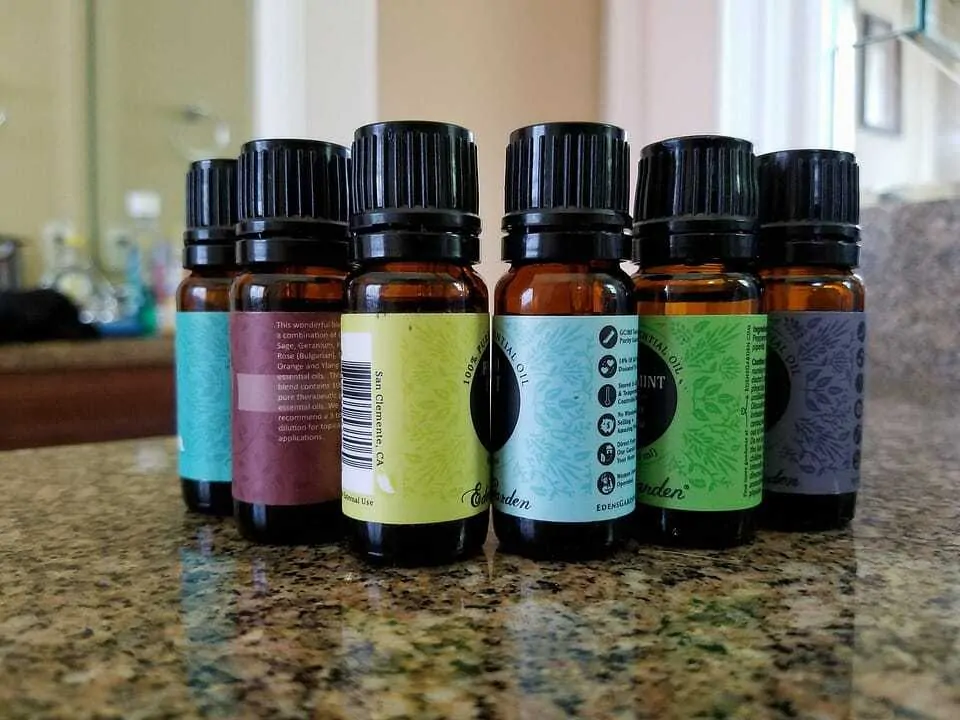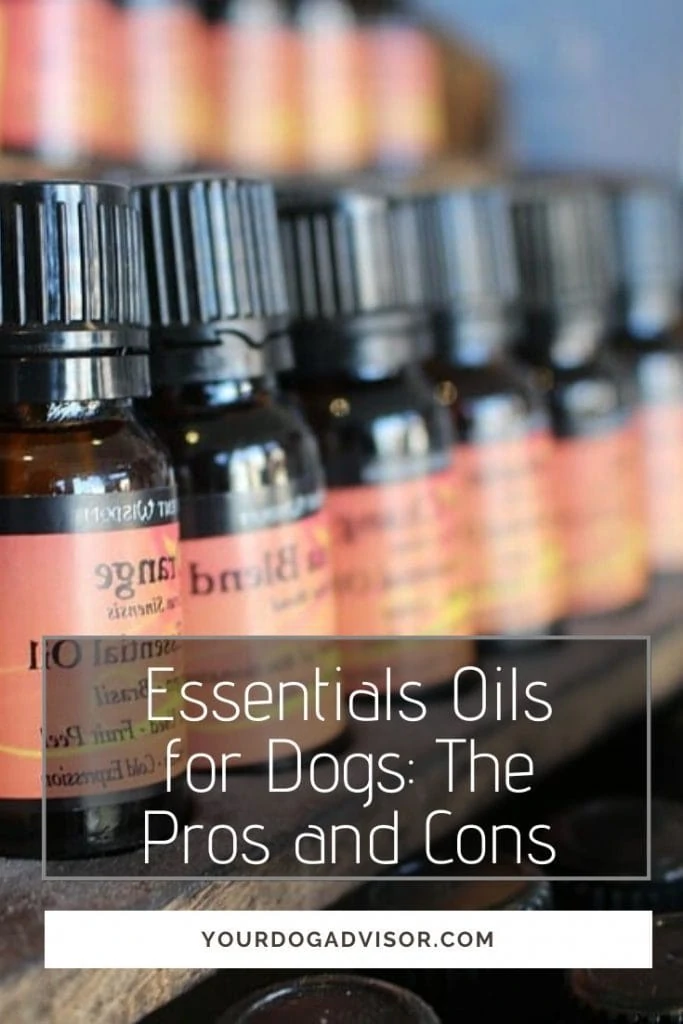Essential Oils are growing in their popularity as an alternative treatment for humans and their pets. It is a booming industry and there are a wide variety of different products and oils available on the market from a huge number of different suppliers. There is often a lot of anecdotal claims of oils being a miracle cure and the marketing around the products can make using them seem very attractive. Whilst early studies and the anecdotal information has been relatively encouraging, if the wrong oils are used or they are administered in an inappropriate way it can have mild to fatal consequences for our pets so great care and research is required before deciding whether to use them.
The use of essential oils is becoming increasingly popular as an alternative treatment for humans and their pets but great care must be taken in ensuring they are safe for your dog
Contents
What Are Essential Oils?
Essential Oils are the extracted and distilled organic part of a plant that contributes to its particular smell and taste. Their quality will depend on a number of factors including how much sunlight they receive, at what altitude they are grown and how much hydration they get. They are volatile compounds which means they turn from liquids into a gas very easily and this is why they are commonly also used for aromatherapy through diffusers. They are very potent in their pure, highly concentrated form.
What Does the Science Tell Us?
Unfortunately, the science tells us very little, to be honest. There have been very few studies conducted on the use of essential oils for dogs and the few that have been done have been small scale and, arguably, inconclusive.
This means that most of the information that we have to go on is anecdotal and experimental and this is why such great care needs to be taken if you decide to use essential oils for your dog.
Always Do Thorough Research Before Using an Essential Oil
It is absolutely vital to do very thorough research before choosing to use an essential oil for your dog. It is not enough that your friend told you they used it for their dog and it worked miracles. It is important to ensure that the oil is on a list of those that are thought to be ‘safe’ for dogs and, even if they are believed to be safe, they will only be so if they are applied in the right measure, method and with the right level of dilution.
Thorough research is required before using an essential oil for your pet. Speak with a Homeopathic Vet if you want to be sure
You May Need to Consult with Your Vet
If you are unsure about the appropriateness of using an essential oil, especially if your dog has a particular health condition then we would always recommend discussing it with your vet before starting to use the oil. A Homeopathic Vet will have a good understanding of what and how the essential oils can be used.
Always Obtain Essential Oils from a Reputable Source
Make sure that the essential oil that you are using comes from a trusted and reputable source. If you don’t there could be things mixed in that could be dangerous for your dog, or the concentration levels, if it is a blend, could be inappropriate. Looking for a 100% pure, certified, therapeutic grade variety is important. Don’t forget though that purity does not mean safety and it is vitally important that you make sure that the oil is appropriate to use with dogs and that, if it is, it is being administered in a safe way and with the correct dosage.
How Best to Use Essential Oils for Your Dog
Essential Oils should NEVER be given orally to your dog and NEVER applied in their concentrated form directly to the skin. This is extremely important. Even a supposedly safe essential oil can be very dangerous when administered in either of these ways.
Again, always make sure that you start with a therapeutic grade oil and then it should be greatly diluted before use. The essential oil is usually diluted with the addition of what is referred to as a carrier oil. The carrier oil dilutes the strength of the very potent essential oil and also acts as a way of ‘carrying’ the oil onto the skin or into the environment.
There are various different carrier oils and they all have different benefits and properties. These include coconut oil and various other vegetable oils. Seeking advice from a Homeopathic Vet to understand which carrier oil and the dilution ratios of the essential oils is often a good option.
The dilution ratios will vary depending on the oil, the carrier and the dog’s weight. It is often recommended starting with an even smaller amount than recommended just in case your dog could have an adverse reaction. Always check the suggested dosage amounts VERY carefully, be mindful of your dog’s weight and size and seek an expert opinion if in doubt.
Even once diluted never apply the mix to delicate areas like the eyes, ears, nose, mouth or around the genital region.
Even when diluted, NEVER apply the essential oil mix to the delicate areas around your dog’s eyes, nose, mouth or ears
Be Mindful of Your Dog When You Are Using Aromatherapy for Yourself
If you are using essential oils in an aromatherapy diffuser in your home it is vitally important that you ensure that the essential oil you are using will not be harmful to your dog. You should also consider their comfort too. Don’t forget that your dog’s sense of smell is thousands of times more sensitive than ours (so strong that they have even been able to detect cancer) and if you have a strong diffuser and your dog is enclosed in the same space as you, they may find the scent overpowering. We would generally recommend having your dog in a separate room, even when you believe the oil to be appropriate for use with dogs. At least make sure that they have the option to move to a space that will not be overpowered by the scent and that you also keep the rooms well ventilated.
Make sure that the oils are stored securely and out of your pets reach at all times too.
If you are using an aromatherapy diffuser around the home make sure the oil is safe around your pet and that they have access to other areas where the smell will not be so overpowering
Consider Any Other Pets in the Household
It is also important to be mindful of any other pets when using a diffuser yourself or when you are applying a treatment for your dog.
Birds are extremely sensitive to essential oils so it is recommended that they are never used around them.
Your cat is more sensitive to a lot of essential oils too. They do not contain the liver enzymes that help them to metabolize a lot of the oils safely. If your cat was to lick an oil off your dog’s skin you could be putting them at risk of being extremely ill if it is one that does not agree with them.
Birds are particularly sensitive to essential oils. Never use a diffuser if you keep birds in the home
When It Is Not Appropriate to Use Essential Oils at All
It is recommended that Essential Oils are never used on young puppies, with pregnant or lactating bitches or for dogs that suffer from epilepsy or some other seizure-inducing condition.
What Should I Do If I Suspect My Dog Has Essential Oil Toxicity or Has Had an Adverse Reaction?
The symptoms of essential oil poisoning can vary greatly. It can depend on which essential oil it was, what the dosage was, how it was administered and the size and other aspects of the individual dog in question.
If you spot any of the following signs after using essential oils it is important to get your dog to the vet as soon as possible. You could also contact the Pet Poison Helpline for expert advice too.
- Becoming lethargic, extra sleepy or seeming depressed
- Having mobility issues such as the wobbles, balance problems, difficulty walking, collapse
- Shaking, muscle tremors or even seizures
- Excess salivation
- Vomiting
- Irritation of the skin
- Problems breathing, coughing
- A drastic change in body temperature
- A change in the heart rate
- An extreme skin reaction
The prognosis for your dog will vary from case to case and it is important to get an appropriate treatment plan in place as soon as possible.
If your dog starts exhibiting unusual behaviour after being exposed to essential oils, like drowsiness or uncoordinated gait or collapse, you should seek medical treatment for them immediately
Which Essential Oils Could Be Appropriate to Use for Your Dog
This list is a general guide including some of the more popular essential oils that are used with dogs. Don’t forget that every dog is different and even essential oils that are purported to be safe for dogs may cause a negative reaction amongst individuals. As mentioned before it is important to do your research, use a therapeutic grade oil with no extra potentially dangerous additions and it must be appropriately diluted with a suitable carrier oil. Always consult with your vet if your dog has a medical condition. If your dog has a respiratory condition, for example, this could cause problems. If your dog has a skin condition this could also impact how the oil is absorbed and also increase the chances of irritation too.
Remember too that whilst these essential oils may have benefits for the conditions listed, there is very little science or studies available to back any of this up so it is mostly anecdotal and experimental evidence.
Lavender Oil
This is one of the most popular essential oils that is safe for use with dogs. It is most commonly used because it is believed that it can help to reduce anxiety levels. When properly diluted it is also often used as a topical treatment to help heal wounds and burns and relieve itching.
It is often used in an attempt to take the edge off stress levels related to separation anxiety, car travel or general fearfulness. For dogs having trouble settling at night, it may help them to get a better nights sleep. The use of Lavender Oil on its own is unlikely to be a cure-all solution but it could be enough to help your dog be more receptive to the training involved in an appropriate desensitisation and counter-conditioning programme. You can purchase calming sprays that already contain lavender oil, like this one from Paws and Pals.
No products found.
Chamomile Oil
Another frequently used option, Chamomile Oil is most commonly associated with being used to treat skin complaints, irritations, burns and wounds because of its anti-inflammatory properties. Like, Lavender, it is also believed to help with reducing anxiety levels. This is why you will often see it being added to treats that are marketed as helping to keep your dog calm, like the MAX Calming Treats for Pets from Mighty Pawz.
Spearmint Oil
It is believed that Spearmint Oil may help with managing gastrointestinal upsets. It is often administered when a dog has general tummy upsets causing vomiting or diarrhoea (obviously for persistent or severe stomach upsets a visit to the vet would be required).
Cedarwood Oil
Cedarwood Oil is purported to have a number of beneficial properties. Amongst other things, some people use it as part of a blend for a natural flea repellant, others if their dog has caught a nasty bout of kennel cough as it is believed it may act as an expectorant and help to expel mucus from the air passages.
There are a number of natural flea and tick sprays on the market that contain Cedarwood Oil, like this one from Nantucket Spider.
Don’t forget that there have been no formal studies around the effectiveness of these natural remedies for flea and tick prevention so you should always keep a close eye on things. See our full article on Fleas for more information on the potential efficacy of different types of treatments.
Some other commonly used essential oils include Cardamom Oil, Peppermint Oil and Fennel Oil.
No products found.
Which Essential Oils Are Toxic for Your Dog
It is important to note that even those oils that may be seen as safe could produce a negative reaction in individual dogs and it also would depend on the dose. So, something may be safe for your dog in very small dosage but if too much is administered then it could prove highly toxic.
Given the lack of scientific data and wide variety of oils available it also means that there may be oils that are toxic to dogs that we are not aware of or that have not yet been reported.
Detailed below, however, are some of those essential oils that are widely recognised as being a large toxicity risk for your dog. It is by no means exhaustive and this is why consulting with an experienced homoeopathic vet can be extremely useful in advance of administering any essential oils.
Tea Tree Oil
The Pet Poison Helpline states that Tea Tree Oil is the most common of the essential oils to be reported to them as having caused toxicity in dogs. The helpline does state though that many of these cases relate to dog owners applying concentrated tea tree oil directly to their dog’s skin without realising the damage it will do.
Tea tree is used in a wide variety of dog products, like dog shampoos, but the amounts used are so small that they would not present a risk.
Pennyroyal
Another one that can cause a lot of problems is Pennyroyal. This is often used as an insect repellant and, if you use a repellant that contains this, its use should be avoided around dogs completely.
Pine Oils
Pine Oils are used in a lot of common household cleaning products and care should be taken to ensure that any floor cleaners and disinfectants that your dog could come into contact with are safe for use around pets and do not contain any of this ingredient.
Some other common essential oils that are problematic for dogs include:
- Juniper
- Clove
- Anise
- Birch
- Camphor
- Ylang Ylang
- Citrus

Gemma is an official dog nut and passionate traveller. Originally from the wonderful city of Edinburgh in Scotland, Gemma is now wandering across Europe with her rescue dog Annie. For ten years Gemma loved being surrounded by all things canine 24/7 whilst she ran a specialist doggy shop. The shop was a great community hub and, along with working closely with local rescues, Gemma provided customer support relating to canine behaviour and nutrition. It was a passion project and one that Gemma felt privileged to have created. She is also studying towards an Advanced Diploma in Canine Behaviour and is a huge advocate of dog rescue and promoting scientific methods of dog training.






